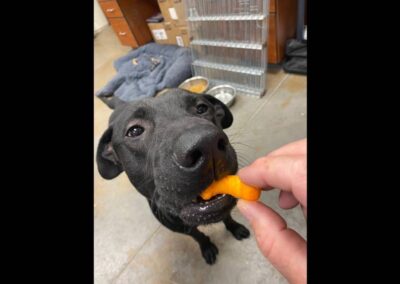
If your dog lunges at dinner time, rushes through doors, or snatches treats before you’re ready—don’t panic.
What you’re seeing isn’t a permanent flaw.
It’s a lack of emotional self-control (also called impulse control)—and the good news is, it can absolutely be taught.
Why Emotional Self-Control Matters
Dogs aren’t born patient. They live in the moment: if something looks exciting, they go for it.
So behaviors like pulling on leash, crashing through doorways, or whining for attention are common.
Left unchecked, these habits stick around.
According to research on canine behavior, teaching impulse control early prevents frustration, reduces anxiety, and helps dogs cope better in stimulating environments.
A calm dog is not just easier to live with—he’s happier, more confident, and better able to navigate daily life.
The principle is simple: teach your dog that good things come from you, not from rushing, grabbing, or demanding.
Four Core Principles of Self-Control Training
1. Rewards come from you, not the environment
If a dog believes food, toys, or access appear through lunging or pushing, they’ll never learn patience. Experts emphasize flipping that belief. Consistently reward calm behavior and waiting, so your dog understands that you control the outcome.
2. Rewards must be earned
Pick a simple default behavior you want—sitting, standing quietly, or keeping all four paws on the floor. Require that before you give anything: food, walks, or access through a doorway. Over time, raise your expectations so your dog learns restraint in all situations.

3. Use games to build self-control
Training doesn’t have to feel like homework. Researchers suggest that dogs learn best through interactive games that make self-control fun:
- Wait for the food dish: Hold the bowl just out of reach. Lower it only when your dog stays calm. If they break position, raise it again. Eventually, they learn sitting quietly makes the bowl come down.
- Leave it: Start with a treat in your closed fist. When your dog stops trying to grab it, reward them with a different treat from your other hand. Later, move to treats on the floor, teaching your dog to resist even when it’s right in front of them.
- Wait at the door: Open the door a crack. If your dog rushes, close it. Repeat until they stay still when the door opens. Add the cue “wait,” and use it for doors, car rides, and even crates.
- Pause during play: In the middle of tug or fetch, ask for a sit or calm behavior. When your dog complies, resume the game. They learn that calmness keeps the fun going.
These games do more than teach obedience—they rewire your dog’s default response to excitement.
4. Be consistent and realistic
Impulse control training isn’t an overnight fix. Each skill needs repetition in different settings before it sticks. Consistency is the difference between a dog who waits calmly at the kitchen door and one who still bolts when the leash comes out.
What Science Says About Impulse Control
It’s tempting to believe once a dog learns self-control in one area, they’ll show it everywhere.
But studies suggest that’s not always the case.
For example, a 2025 study tested dogs trained in agility and scent work against regular pets on a self-control challenge.
Surprisingly, highly trained dogs didn’t always outperform pet dogs—sometimes they even did worse in certain tasks.
The takeaway? Impulse control doesn’t automatically transfer across situations.
That means you need to train specifically for the contexts you care about: mealtimes, walking on leash, greeting guests, and so on.
Each scenario builds a different layer of emotional restraint.

A Sample Training Progression
Here’s one way to structure practice:
- Start small: Indoors, with no distractions, work on “wait for bowl” and “leave it.”
- Add mild challenges: Try dropping a treat on the floor or opening a door slightly.
- Increase difficulty: Practice outside, at doors, or near distractions.
- Mix it up: Sometimes reward with access, sometimes don’t. Teach your dog to trust your cues, not patterns.
- Reinforce everywhere: Notice calm behavior in daily life and reward it—on walks, at home, when guests arrive.
This layering approach ensures your dog’s patience holds up in real life.
Why It’s Worth the Effort
A dog with emotional self-control is less likely to bolt, grab food, or jump on strangers.
Instead, they pause, look to you, and respond predictably when things get exciting.
For you, the payoff is enormous: fewer accidents, less chaos, and more peace of mind.
For your dog, it’s the confidence of knowing what’s expected and the ability to handle life without constant stress.
Teach your dog self-control, and you don’t just get better behavior—you get a calmer, happier companion.



